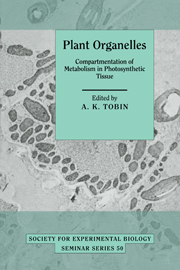Book contents
- Frontmatter
- Contents
- List of Contributors
- Preface
- Acknowledgements
- Metabolic interactions between organelles in photosynthetic tissue: a mitochondrial overview
- Metabolite transport in plant cells
- Metabolic interactions during photosynthetic and respiratory nitrogen assimilation in a green alga
- Carbon and nitrogen cycling between organdies during photorespiration
- Metabolic interactions between organelles in C4 plants
- Metabolic interactions in leaves of C3–C4 intermediate plants
- Metabolite compartmentation and transport in CAM plants
- Transport of H+, K+ and Ca2+ at the vacuolar membrane of plants
- Regulation of mitochondrial respiratory activity in photosynthetic systems
- Biosynthesis and assembly of the enzymes involved in lipid metabolism in plants
- The role of carnitine in plant cell metabolism
- Metabolic interactions of organelles in guard cells
- Transport of proteins into chloroplasts
- Metabolic interactions of organelles during leaf development
- Index
Metabolic interactions between organelles in photosynthetic tissue: a mitochondrial overview
Published online by Cambridge University Press: 05 December 2011
- Frontmatter
- Contents
- List of Contributors
- Preface
- Acknowledgements
- Metabolic interactions between organelles in photosynthetic tissue: a mitochondrial overview
- Metabolite transport in plant cells
- Metabolic interactions during photosynthetic and respiratory nitrogen assimilation in a green alga
- Carbon and nitrogen cycling between organdies during photorespiration
- Metabolic interactions between organelles in C4 plants
- Metabolic interactions in leaves of C3–C4 intermediate plants
- Metabolite compartmentation and transport in CAM plants
- Transport of H+, K+ and Ca2+ at the vacuolar membrane of plants
- Regulation of mitochondrial respiratory activity in photosynthetic systems
- Biosynthesis and assembly of the enzymes involved in lipid metabolism in plants
- The role of carnitine in plant cell metabolism
- Metabolic interactions of organelles in guard cells
- Transport of proteins into chloroplasts
- Metabolic interactions of organelles during leaf development
- Index
Summary
The photosynthetic cell is particularly active when illuminated and interactions occur among chloroplasts, mitochondria, peroxisomes and the cytoplasm, which, although not an organelle, represents a separate cellular compartment. For one organelle to affect the metabolism of another there needs to be a transfer of metabolites so that the second organelle experiences a changed metabolite condition (e.g. substrate:product; NADH:NAD; ATP:ADP). This metabolite transfer may occur directly between organelles when their membranes are in contact or, indirectly, into the medium common to both, i.e. the cytoplasm. These metabolic interactions are dependent on metabolite transport across organelle membranes (Heldt & Flügge, 1987).
The phosphate translocator of chloroplasts can elevate the cytoplasmic concentrations of triose-P, ATP and reduced NAD. These compounds influence mitochondrial respiration by acting as substrates or as feedback inhibitors, producing adenylate or respiratory control. Metabolic control results from complex, multi-component interactions and is best understood with metabolic control analysis (Kacser, 1987).
Much has been written about the persistence of mitochondrial activity (tricarboxylic acid cycle turnover, electron flow and oxidative phosphorylation) in illuminated leaves. The comments have ranged from a complete shutdown of mitochondrial activity imposed by the high cytosolic ATP/ADP ratios in the light (Heber, 1974); maintenance of TCA cycle activity (Azcón-Bieto & Osmond, 1983); increased rates of oxygen uptake (Azcón-Bieto & Day, 1983; Stitt et al., 1985 – although not necessarily linked to ATP synthesis) to a dependence of photosynthetic activity on mitochondrial oxidative phosphorylation (Krömer et al., 1988). The current view is that mitochondrial activity, including oxidative phosphorylation, does persist in leaf cells during photosynthesis.
- Type
- Chapter
- Information
- Plant OrganellesCompartmentation of Metabolism in Photosynthetic Tissue, pp. 1 - 20Publisher: Cambridge University PressPrint publication year: 1992
- 1
- Cited by



